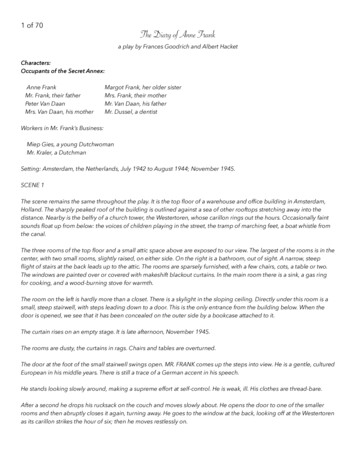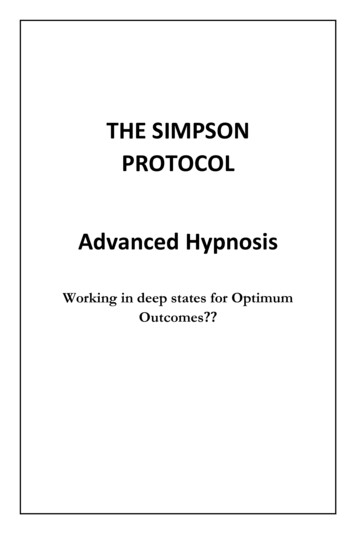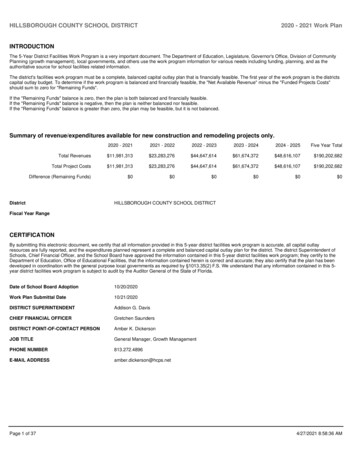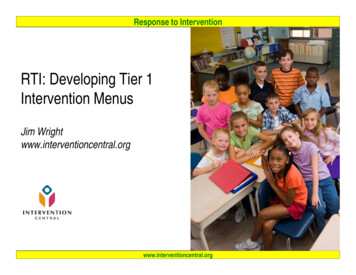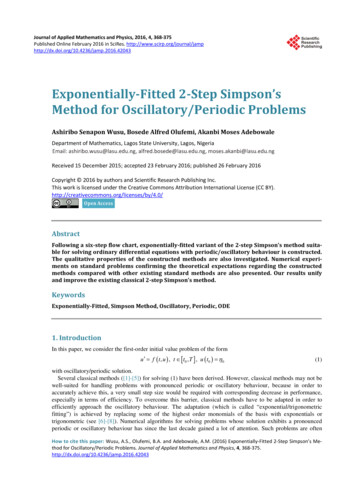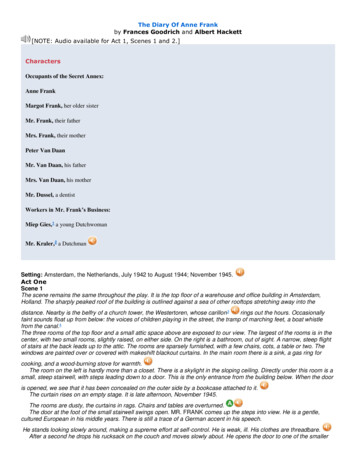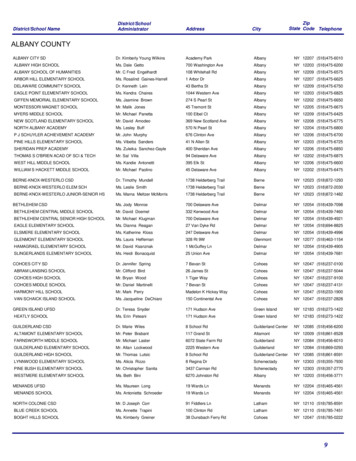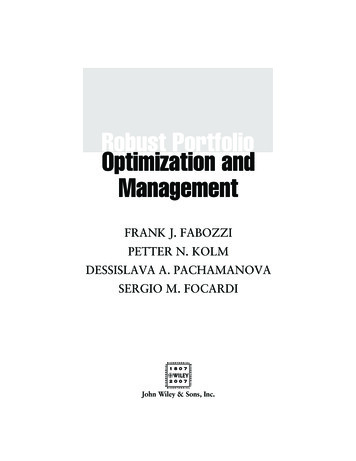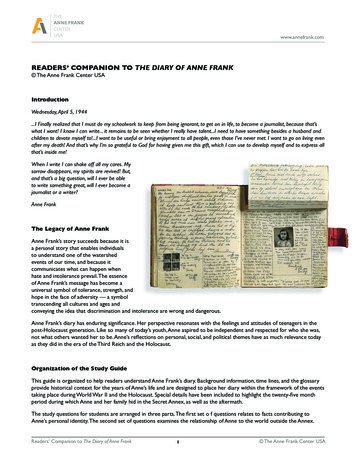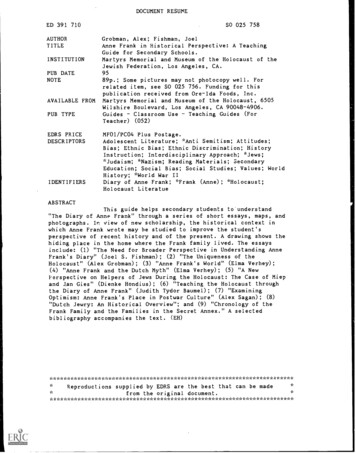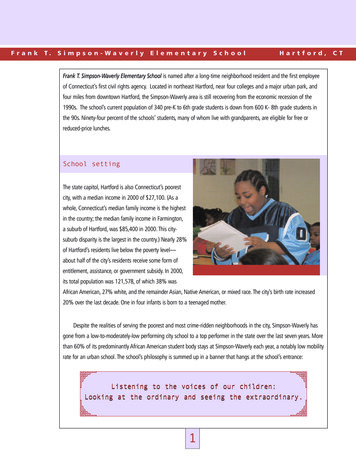
Transcription
nk T. Simpson-Waverly Elementary School is named after a long-time neighborhood resident and the first employeeof Connecticut’s first civil rights agency. Located in northeast Hartford, near four colleges and a major urban park, andfour miles from downtown Hartford, the Simpson-Waverly area is still recovering from the economic recession of the1990s. The school’s current population of 340 pre-K to 6th grade students is down from 600 K- 8th grade students inthe 90s. Ninety-four percent of the schools’ students, many of whom live with grandparents, are eligible for free orreduced-price lunches.School settingThe state capitol, Hartford is also Connecticut’s poorestcity, with a median income in 2000 of 27,100. (As awhole, Connecticut’s median family income is the highestin the country; the median family income in Farmington,a suburb of Hartford, was 85,400 in 2000. This citysuburb disparity is the largest in the country.) Nearly 28%of Hartford’s residents live below the poverty level—about half of the city’s residents receive some form ofentitlement, assistance, or government subsidy. In 2000,its total population was 121,578, of which 38% wasAfrican American, 27% white, and the remainder Asian, Native American, or mixed race. The city’s birth rate increased20% over the last decade. One in four infants is born to a teenaged mother.Despite the realities of serving the poorest and most crime-ridden neighborhoods in the city, Simpson-Waverly hasgone from a low-to-moderately-low performing city school to a top performer in the state over the last seven years. Morethan 60% of its predominantly African American student body stays at Simpson-Waverly each year, a notably low mobilityrate for an urban school. The school’s philosophy is summed up in a banner that hangs at the school’s entrance:Listening to the voices of our children:Looking at the ordinary and seeing the extraordinary.1CT
7: the state of Connecticut takes controlIn 1996, a state education department assessment conductedby the Northeast Regional Laboratory based at BrownUniversity, found that Hartford Schools were failing theirstudents. Despite efforts to equalize the resources given toall Connecticut cities, Hartford students’ achievement scorescontinued to decline compared with other cities; the city highschool, the oldest public high school in the nation, wasthreatened with the loss of accreditation. At the same time, inthe landmark Sheff v. O’Neill lawsuit, the state Supreme Courtfound that the State of Connecticut had not done enough to reduce racial isolation within the capitol city’s schools.Ordered to desegregate Hartford schools, the State dissolved the city’s school board and appointed a state board to helpturn things around in Hartford.On June 1, 1997, a specially appointed panel took formal control of the Hartford public schools and hired AnthonyAmato, Hartford’s superintendent of schools from 1999-2002. Aware that many students’ families moved frequently,disadvantaging the students as they changed schools and curricula each time, Mr. Amato introduced a literacy program,Success For All (SFA), and standardized academic content across the district with common pacing guides, curriculummaterials, and assessments.Although these events galvanized many educators, Simpson-Waverlyhad already begun improving: its Overall School Index (a state rank score)jumped from 24% to 46% from 1995 to 1997. Principal James Thompsonand his staff had created a new School Improvement Plan that reflected thestate and new district standards. Aligning instruction with the new pacingguides and curricula, using state, district, and classroom assessments andstudent work to monitor student performance, they had also developed amore structured and formal mechanism to address student academicperformance. “I realized that it would not be enough to have only myself andthe teacher look at the student portfolios to develop instructional strategies.We really needed a team of people working together and brainstorming together, said Mr. Thompson.”2CT
ith staff input, Mr. Thompson created the Student Academic Review (StAR) to monitor student achievement, andSimpson-Waverly began its climb to success. In time it became a top performer in statewide assessments, outperformingsome of its more affluent, suburban neighbors.Student Academic Review: everyone is accountableOnce a month, classroomThe Simpson-Waverly Student Academic Review:teachers join the StAR team—comprising, at a minimum, thevice principal, internal literacy Monitors school-wide curriculum implementationcoach, district math consultant, Monitors school-wide instruction to ensure the curriculum is aligned with districtand the state writing projectconsultant—to review studentportfolios in reading, writing, andand state framework Monitors student progress and initiativesmathematics. Under this model, Tailors teaching and learning strategies and interventions to individual studentsSimpson-Waverly welcomes state Leads to a targeted staff development planand district experts, who takepart in StAR brainstormingand targeted professional Holds administration, teachers, and students accountable for academic achievement Fosters an atmosphere of collegiality and teamwork and identifies in-house expertsdevelopment for Simpson-Waverlystaff, and encourages “in-house” experts to join the StAR team and ultimately model in-class instruction.The StAR model draws on student portfolios to gather a compellingpicture of where each student is relative to the curriculum. Teachers alsoshare the portfolios with other educators in order to brainstorm individualsolutions to student needs. The portfolios are not teacher evaluations, butdemonstrations of monthly student progress. They include a table ofcontents, weekly tests, district quarterly tests, publishers’ tests, and currentsamples of student work. In advance of the StAR meeting, each teacherThe StAR Team listensas teachers discussthe curriculum andpacing charts.organizes his or her students’ portfolios into three groups: those whomeet the standards, those on the “cusp” (who could meet for fall belowstandards soon), and those who fall below the standards.3
ing the team meeting, each StAR team member takes 4-5 portfolios, reviews them, notes trends and changes,and then poses questions about specific instructional and intervention strategies or supports that might improve theindividual student’s learning. The StAR Team listens as teachers discuss the curriculum and pacing charts. The team mayask questions such as “What concepts are difficult for the kids?” They may notice that several students are missing aspecific skill such as estimation and suggest ways to introduce it differently. Teachers use this forum to raise concernsabout students and the pacing guides with the StAR Team who then can provide support and suggestions. Mr. Thompsonexplained the power of the StAR as a source of teacher strength, saying, “When making decisions, you should not be inisolation. To know how you are doing, for validation and improvement, you need your peers.”Observers such as the superintendent, principals from other Hartford schools, and principals from other state districtsoften attend the StAR meetings. Mr. Thompson always asks for visitors’ feedback about improving the StAR process andhow it might unfold in their schools. Following numerous requests to discuss StAR at numerous district meetings andmentor other principals in establishing StAR in their schools, Mr. Thompson is now working with a district consultant todevelop a StAR training manual that will be available electronically and include forms, charts, and activities.“StAR keeps everyone on track,” Mr. Thompson said. “It brings accountability to the classroom level, but there mustbe follow-up. That is key.” As a result, the literacy coach may schedule classroom visits to model a lesson or coach ateacher, the social worker may get referrals and meet with students, the Student Assistance Team may get referrals, Mr.Thompson may arrange for more literacy tutors, or the math and writing consultants may attend grade level meetings todiscuss issues or concerns. Essentially every member of the school community is accountable for student learning, fromthe principal to paraprofessionals.However, before the staff could begin to push students towardsacademic excellence, as a community the school developed and supportedthe School Improvement Plan this included benchmarks for measuringsuccess within the mission statement and the goals and objectives thatfollowed. The Student Academic Review became the mechanism by whichthe staff assessed their progress towards achieving their goals and chartedtheir next course towards new goals.4CT
n the No Child Left Behind legislation became the new benchmark for measuring progress, the staff had alreadymade important gains, however Adequate Yearly Progress was still a daunting bar to vault. “We were so afraid that wewould not make AYP,” recalled the principal, “we made our first goal that 10% of our third graders would be proficient,and then moved the bar higher and higher. As we started to do it, we began to believe in ourselves. Initially we did nothit it in all areas, but we hit it in some.”A classroom poster sumsup the message:Setting the paceThat incremental but steady push for success paid off. Today, studentsand parents alike know that Simpson-Waverly is about academicGood better bestsuccess. “We have high expectations for our students,” a teacher said.Ms. Register will not let me rest“We involve them in the review of work, showing them that they canUntil my good is bettergo there and not expecting less.”And my better is bestHigh expectations extend beyond academics to include respect for self and others. Students take pride in their schooland graffiti do not deface the school building. Over the last two years, Mr. Thompson said, the school “put in a lot ofpreventive measures” such as education on health, violence prevention, character development and peer mediation, thatenabled the school to look at and address risk factors and social issues students confront. The school created a healthyenvironment that builds on young people’s assets, explained the school prevention specialist, “The evidence is thatstudents can change behavior to focus on academics. It is not that children cannot learn but that there are some factorsthat prevent children from learning.”Running a “tight ship”Retiring this year, Mr. Thompson has led Simpson-Waverly for 17years. The current superintendent Robert Henry, said ofThompson: “[He] has clear benchmarks for everyone and hebrings accountability in a non-threatening and supportive way.”The district turn-around specialist, present at Simpson-WaverlyJames Thompson has ledSimpson-Waverly for 17 years.5CT
ee times a week to assist with curriculum, instruction, and assessment, added, “He is very particular but he is easy towork with and to talk to. His style is involved.” Mr. Thompson “meets with each grade level team during their commonplanning time to review changes in instructional strategies based on test scores,” the turn around specialist said,“Nothing really happens without the principal knowing.”A district consultant concurs: “Dr. Thompson runs a tight ship. He is a talent scout. He finds each person’s talent andlets them run with it. Although he is highly structured, he lets go of the reins. He empowers staff members to see thatthey have a role in the direction that they are going. Staff has a clear vision and he helps with resources.” A teacheradded, “He says, ‘these are the scores, this is what is lacking, this is what we are going to do, and this is how we aregoing to check our progress.’” This level of attention has in turn led to a stable and veteran corps of staff members, thesuperintendent said.Steeping students in classical learningThe district supports many additional learning opportunities for targeted children. They include an extended day “PowerHour,” Saturday Academies, Summer School, and year-around pre-kindergarten. About a third of all students in grades 3through 6 participate in the Classical Magnet Program. Based on the Socratic (Paideia) method pioneered by St. John’sCollege in Maryland, this weekly classical program promotes higher order thinking skills.Once a month, professors from Trinity College conductcollege-like seminars, guiding students in analyzing and critiquingliterature. In a recent visit, a Trinity professor lectured the studentson the difference between perspective and perception, the classdiscussed a reading, and students wrote about situations wheretheir perspective on a person changed as a result of someperception about him or her. Participants are expected to keep upwith their regular classroom work. Teachers are trained in thismodel and next year, Simpson-Waverly will become a schoolwideClassical Program.6CT
FrankT.Simpson-WaverlyElementarySchoolHartford,An “unrufflable” staffLeadership and accountability at Simpson-Waverly include everyone. Teachers mentor other teachers and sit on the SchoolImprovement Team, which meets monthly. This team includes teachers from the lower school (grades K-3), the upperschool (grades 4-6) and Special Education, as well as three to four parents, the family resource aide, a paraprofessional,the literacy facilitator, the turn-around specialist, and the principal. The team addresses school progress and provides acommon, coordinated and sustained school program.Staff members at SimpsonWaverly have been looking atinformation and using data for along time; their ongoing reflectionon student progress shapes theschool’s direction. Strategies growdirectly out of students’ needs. Thatthe school functions as acoordinated whole is evident in thecommon instructional practices in use from classroom toclassroom. Teachers engage students through both largeStaff members’ ongoing reflectionon student progress shapes theschool’s direction.and small group instruction, cooperative learning,guided inquiry, and discussions. Students learn how to use graphic organizers, to plan a rough draft around a structured“pillar,” and to highlight or underline text as they look for main and supporting ideas.They also learn what it means to be a productive member in a cooperative group and engage in good groupdiscussion. In a second grade classroom, students were reading their first expository text, and the teacher prompted themto state what they do to find the main idea. The students replied: “Survey the whole story. Ask questions. Read. Rereadand Respond. And Learn,” an approach known by its acronym, SQURRRL. After reading the text aloud, they discussed it incooperative groups. The teacher reinforced the cooperation by asking, “What did your team say?” and “Did youcontribute? The only way to have a good team is to contribute.”7CT
FrankT.Simpson-WaverlyElementarySchoolHartford,Mr. Thompson’s “inner drive” has resulted in a stable and veteran staff,according to the superintendent. Teachers described the teaching andadministrative staff at Simpson-Waverly as dedicated, qualified, and seasoned.One teacher observed, “Nothing ruffles us. We always work around and with it.We rely on resolve.” A student said, “I’ve only been here a couple of monthsbut the teachers are nice. They help me with math when I do not understand.”Other student comments include: “Everyone here cares a lot and you get thehelp you need;” “I like to read and write;” “Teachers take time to explainstuff;” and, “They are teaching important things that we do not know.”Students said they felt they would use what they were learning in school intheir future, and that they had a strong sense that their education and future were important.Students felt that their schooling had a direct effect on their lives. Onestudent said “here you get help with your academics and with your life. Ilearned that it is important to postpone sex until after my education.” Astudent who plans to be a lawyer praised his training: “During Seminar Ilearn to talk and question. We have speech contests and I . . . work on myspeech.” Students appear to feel tremendous gratitude for their school andwhat it has done for them. The imprint that Simpson-Waverly leaves onthese students was summed up beautifully by a student who said, “When Igrow up, I want to be a teacher so that the things I learned at this school I could instill in other kids so when they growup I will have made a difference in their lives”.Mr. Thompson will retire this year but may remain in education in some way. Several teachers observed that thestructures and community he has created are self-sustaining. Mr. Thompson agreed, “You are a good administrator if youcan make yourself obsolete.”8CT
Frank T. Simpson-Waverly Elementary Schoolis named after a long-time neighborhood resident and the first employee of Connecticut's first civil rights agency. Located in northeast Hartford, near four colleges and a major urban park, and four miles from downtown Hartford, the Simpson-Waverly area is still recovering from the economic recession .
